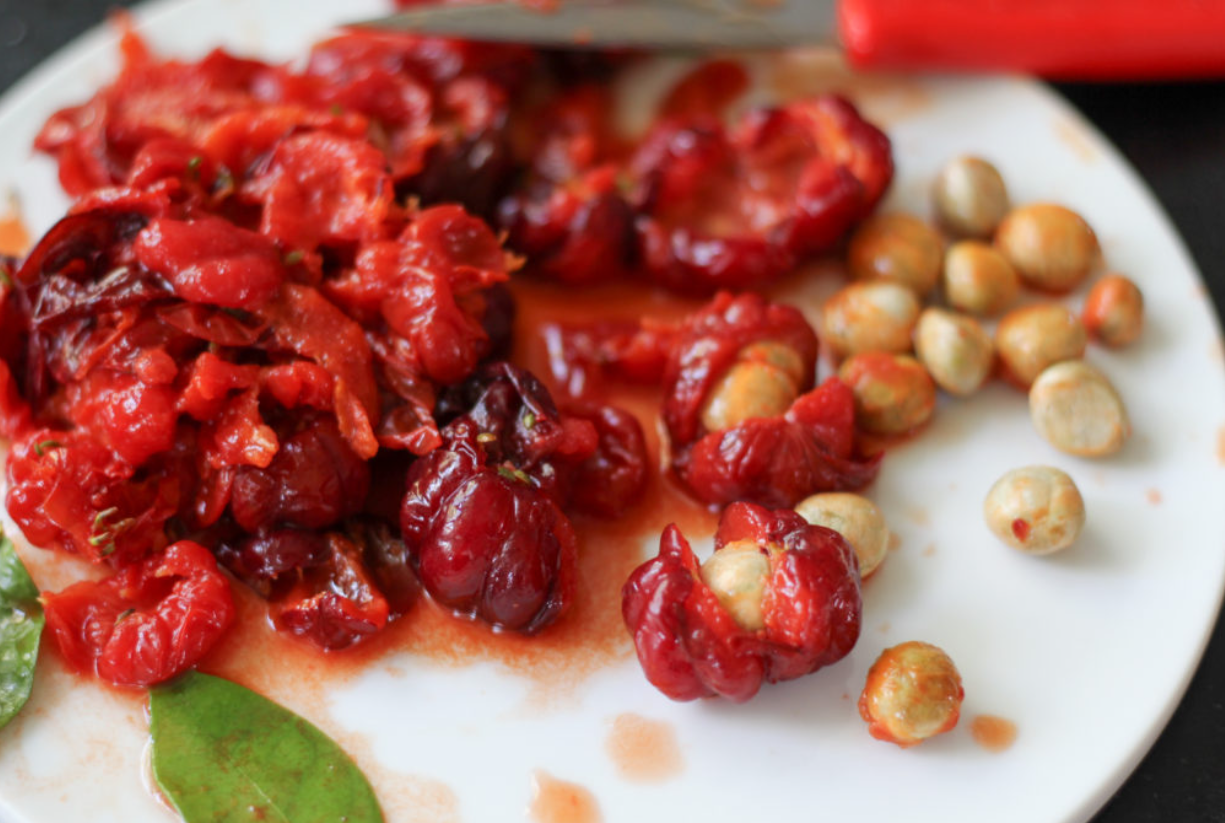Health
Surinam Cherry: A Comprehensive Guide
Published
10 months agoon
By
Bilal
Surinam cherry (Eugenia uniflora), also known as the Brazilian cherry or Pitanga, is a small, tropical fruit that boasts a unique combination of flavors, vibrant colors, and an array of health benefits. Native to South America, particularly Brazil and Suriname, this fruit has gained popularity in various parts of the world, including Florida and other subtropical regions.
The Surinam cherry is not just valued for its taste; it is also appreciated for its ornamental value, often grown as a hedge or in bonsai form. However, there’s much more to this fruit than meets the eye. This comprehensive guide will delve into the many facets of Surinam cherry, from its taste and nutritional benefits to its cultivation and uses.
The Surinam Cherry Tree: A Botanical Overview
The Surinam cherry tree is a hardy, evergreen shrub or small tree that can grow up to 25 feet tall, though it often remains smaller when cultivated in gardens or as a hedge. The tree is characterized by its glossy, dark green leaves that release a pleasant aroma when crushed. The bark is smooth, and the tree produces small, white flowers that give way to the fruit.
Surinam Cherry Tree Pictures
 Visual representation of a Surinam cherry tree.
The fruit itself is small, typically about 2 cm in diameter, and has a ribbed appearance. As it ripens, the Surinam cherry changes color, transitioning from green to bright orange and then to a deep, rich red or even black. The color of the fruit can give a clue to its taste, with the darker varieties generally being sweeter.
Surinam Cherry: Historical and Cultural Significance
The Surinam cherry holds a special place in the cultural and historical contexts of the regions where it is native. In Brazil, for instance, it is often associated with traditional medicine and is commonly found in local markets. The fruit’s high vitamin C content made it a valuable resource in times when scurvy was a common concern among sailors and explorers.
In Suriname, the fruit is deeply intertwined with local customs and is often included in rituals and celebrations. The Surinam cherry’s vibrant color and unique flavor have made it a favorite among locals, who enjoy it fresh or in a variety of traditional dishes.
What Does Surinam Cherry Taste Like?
The taste of Surinam cherry is as unique as its appearance. Often described as a blend of sweetness and tartness, the flavor profile can vary depending on the variety and ripeness of the fruit. When fully ripe, the Surinam cherry has a sweet, tropical taste with hints of apricot, mango, and cranberry. However, if picked too early, the fruit can be quite tart, sometimes even resinous.
Surinam Cherry Taste
The unique flavor of Surinam cherry makes it a versatile ingredient in various culinary applications. It can be eaten fresh, made into jams, jellies, or even fermented into wines and liqueurs. The fruit’s distinct taste also pairs well with both sweet and savory dishes, adding an exotic twist to traditional recipes.
Culinary Uses of Surinam Cherry
In the kitchen, Surinam cherry can be used in a variety of ways. Its vibrant color and sweet-tart flavor make it an excellent choice for desserts, such as pies, tarts, and sorbets. The fruit can also be used to make chutneys and sauces that pair well with meats and cheeses.
In beverages, Surinam cherry juice is a refreshing drink, often mixed with other tropical fruits to create a flavorful and nutritious concoction. The fruit can also be fermented to produce a unique, aromatic wine, which is a popular choice among home winemakers.
Surinam Cherry in Traditional Medicine
Beyond its culinary uses, Surinam cherry has been used in traditional medicine for centuries. In its native regions, the fruit and leaves are used to treat a variety of ailments, including digestive issues, respiratory problems, and even as a remedy for fever. The high vitamin C content of the fruit is believed to boost the immune system, while the leaves are often brewed into a tea that is used to alleviate symptoms of colds and flu.
Surinam Cherry Benefits: More Than Just a Pretty Fruit
Surinam cherry is not just a treat for the taste buds; it also offers numerous health benefits. Rich in vitamins A and C, this fruit supports the immune system, promotes healthy skin, and aids in vision. Additionally, Surinam cherry is a good source of antioxidants, which help combat oxidative stress and reduce the risk of chronic diseases.
Nutritional Facts
- Calories: 5 calories per fruit
- Vitamin A: 20% of the daily recommended intake
- Vitamin C: 30% of the daily recommended intake
- Fiber: 1 gram per fruit
These nutritional benefits make Surinam cherry an excellent addition to a balanced diet, particularly for those looking to boost their vitamin intake naturally.
Health Benefits of Surinam Cherry
- Boosts Immune System: The high vitamin C content in Surinam cherry helps strengthen the immune system, making it more effective at fighting off infections and illnesses.
- Promotes Healthy Skin: Vitamin A in the fruit aids in maintaining healthy skin, reducing the appearance of fine lines and wrinkles, and promoting an even skin tone.
- Supports Vision: Vitamin A is also essential for good vision, particularly in low-light conditions. Regular consumption of Surinam cherry can help maintain healthy eyesight.
- Aids Digestion: The fiber content in Surinam cherry promotes healthy digestion and can help prevent constipation. It also supports the growth of beneficial gut bacteria.
- Reduces Inflammation: The antioxidants in Surinam cherry help reduce inflammation in the body, which can lower the risk of chronic diseases such as heart disease and arthritis.
Growing and Caring for a Surinam Cherry Tree
If you’re considering adding a Surinam cherry tree to your garden, you’ll be pleased to know that it’s relatively easy to grow, provided it’s planted in the right conditions. Surinam cherry thrives in warm, subtropical climates and can tolerate a range of soil types, though it prefers well-drained, slightly acidic soil.
Caring for a Surinam Cherry
- Sunlight: Surinam cherry trees require full sun to partial shade to thrive. Ensure they receive at least 6 hours of sunlight daily.
- Watering: Water the tree regularly, especially during dry periods. However, avoid overwatering, as this can lead to root rot.
- Fertilizing: Feed the tree with a balanced fertilizer during the growing season to promote healthy growth and fruit production.
- Pruning: Regular pruning helps maintain the shape of the tree, particularly if you’re growing it as a hedge. Remove any dead or diseased branches to encourage healthy growth.
Surinam Cherry Growing Zone
Surinam cherry is hardy in USDA zones 9 through 11. It can withstand short periods of cold, but prolonged exposure to freezing temperatures can damage the tree. In colder climates, consider growing Surinam cherry in a container that can be moved indoors during the winter months.
Propagating Surinam Cherry
Surinam cherry can be propagated by seeds or cuttings. Seeds should be sown in a well-draining soil mix and kept moist until germination, which typically occurs within 2-4 weeks. Cuttings should be taken from healthy, mature wood and treated with a rooting hormone to encourage root development.
Once established, Surinam cherry is relatively low-maintenance, requiring only regular watering and occasional fertilization. With proper care, the tree will begin to produce fruit within 2-3 years.
Pest and Disease Management
Surinam cherry is generally resistant to pests and diseases, but it can be susceptible to certain issues, such as root rot, particularly if grown in poorly drained soils. To prevent this, ensure the tree is planted in well-drained soil and avoid overwatering.
In some regions, the tree may also be affected by aphids, scale, and fruit flies. Regular monitoring and the use of organic pest control methods, such as neem oil, can help keep these pests in check.
Surinam Cherry Hedge: A Natural and Functional Choice
One of the most popular uses for Surinam cherry is as a hedge. Its dense foliage and attractive appearance make it an excellent choice for creating natural barriers or privacy screens in gardens. When planted closely together, Surinam cherry trees form a thick, impenetrable hedge that not only looks beautiful but also serves a functional purpose.
Creating a Surinam Cherry Hedge
To create a Surinam cherry hedge, space the plants about 3 to 5 feet apart, depending on the desired density. Regular pruning will help maintain the shape and size of the hedge, and with proper care, it can remain lush and vibrant year-round.
Benefits of a Surinam Cherry Hedge
- Privacy: A Surinam cherry hedge provides an effective natural screen, blocking out noise and providing privacy from neighbors or passersby.
- Wildlife Habitat: The dense foliage of the hedge offers a habitat for birds and beneficial insects, making it an excellent choice for wildlife-friendly gardens.
- Aesthetic Appeal: With its glossy green leaves and vibrant red or black fruit, a Surinam cherry hedge adds visual interest to any garden, particularly during the fruiting season.
Maintenance Tips for Surinam Cherry Hedge
Regular pruning is essential to keep the hedge in shape and encourage healthy growth. It’s best to prune the hedge after the fruiting season to avoid removing potential fruit buds. Mulching around the base of the hedge can help retain moisture and suppress weeds.
Black Surinam Cherry: A Darker, Sweeter Variety
While the red Surinam cherry is the most common variety, there is also a less common black variety that is prized for its sweeter taste. Black Surinam cherry is similar in size and shape to its red counterpart, but it tends to be less tart and more flavorful, making it a favorite among those who prefer a milder, sweeter fruit.
Is Surinam Cherry Poisonous?
There is often concern about the toxicity of certain plants and fruits, but rest assured that Surinam cherry is completely edible and safe to consume. However, like many fruits, the seeds of Surinam cherry contain small amounts of cyanogenic glycosides, which can release cyanide when consumed in large quantities. Therefore, it’s best to avoid eating the seeds and focus on enjoying the delicious fruit.
Culinary Uses of Black Surinam Cherry
The black variety of Surinam cherry is particularly well-suited to desserts, thanks to its sweeter flavor. It can be used in the same way as the red variety, in pies, jams, and sauces, but its milder taste makes it especially popular in fruit salads and as a topping for cakes and pastries.
Surinam Cherry in Florida: A Tropical Delight
In Florida, Surinam cherry has become a popular fruit, particularly in the southern regions where the climate is ideal for its growth. The fruit is commonly found in gardens, parks, and even as wild-growing plants. Surinam cherry’s ability to thrive in Florida’s warm, humid environment makes it a favorite among local gardeners and fruit enthusiasts.
Growing Surinam Cherry in Florida
Florida’s sandy soils and subtropical climate provide the perfect conditions for growing Surinam cherry. The tree’s drought tolerance also makes it well-suited to Florida’s occasional dry spells, though regular watering will ensure a more bountiful harvest.
Challenges of Growing Surinam Cherry in Florida
While Surinam cherry thrives in Florida, it is not without its challenges. In some areas, the tree has become invasive, spreading rapidly and outcompeting native plants. Gardeners are encouraged to monitor the growth of Surinam cherry and take steps to prevent it from spreading uncontrollably.
Additionally, the warm, humid climate of Florida can attract pests such as fruit flies, which may damage the fruit. Regular monitoring and the use of organic pest control methods can help mitigate this issue.
Surinam Cherry Plant: A Versatile Addition to Your Garden
Whether you’re growing Surinam cherry as a tree, a hedge, or even a bonsai, this plant is a versatile addition to any garden. Its attractive foliage, fragrant flowers, and delicious fruit make it a multi-purpose plant that adds both beauty and utility to your outdoor space.
Surinam Cherry Bonsai
For those interested in bonsai, Surinam cherry makes an excellent choice due to its small leaves and natural branching structure. With regular pruning and care, a Surinam cherry bonsai can be a stunning focal point in any collection.
Tips for Growing Surinam Cherry Bonsai
Growing Surinam cherry as a bonsai requires regular attention to pruning and shaping. The tree responds well to pruning, making it easy to maintain the desired shape. It’s important to use sharp, clean tools to avoid damaging the tree, and to prune regularly to keep the tree healthy and compact.
The bonsai should be kept in a location with plenty of sunlight, and watered regularly to keep the soil moist but not waterlogged. Fertilize the bonsai with a balanced fertilizer during the growing season to promote healthy growth.
Surinam Cherry: A Fruit for All Seasons
In conclusion, the Surinam cherry is a fruit that offers much more than meets the eye. From its unique taste and health benefits to its versatility in the garden, this fruit is a valuable addition to any home. Whether you’re growing it for its fruit, as a hedge, or as an ornamental plant, Surinam cherry is sure to bring a touch of tropical charm to your space.
| Aspect | Details |
|---|---|
| Scientific Name | Eugenia uniflora |
| Common Names | Surinam cherry, Brazilian cherry, Pitanga |
| Family | Myrtaceae |
| Origin | South America (Brazil, Suriname) |
| Growing Zones | USDA zones 9-11 |
| Preferred Climate | Warm, subtropical to tropical |
| Tree Height | Up to 25 feet (can be smaller in cultivation) |
| Fruit Color | Red, black |
| Fruit Taste | Sweet-tart, tropical, with hints of apricot and cranberry |
| Nutritional Benefits | High in vitamins A and C, antioxidants |
| Uses | Fresh consumption, jams, jellies, hedges, bonsai |
| Toxicity | Seeds contain small amounts of cyanogenic glycosides (avoid seeds) |
| Cultural Significance | Popular in Brazil, Suriname, Florida |
Conclusion
The Surinam cherry is much more than just an exotic fruit; it’s a versatile, nutrient-rich plant that brings a touch of the tropics to any garden or home. Whether you’re drawn to its unique, sweet-tart flavor, its health-boosting properties, or its ornamental beauty, the Surinam cherry offers something for everyone. From its rich historical roots in South America to its growing popularity in subtropical regions like Florida, this fruit has made its mark as both a culinary delight and a gardener’s favorite.

Who Is Lynn Hamilton? Celebrating the Life and Legacy of the American Actress

Who is Mickey Gooch Jr? The Dynamic Journey of a Film Producer and Actor

Who Is Pierre Bouvier? All About the Canadian Singer and Musician Behind Simple Plan

Who Is Pearl Minnie Anderson? Rising Star in Maya Rudolph’s Legacy

Who is Minnie Pearl? The American Comedian Who Brought Country Humor to the Spotlight

Who Is Kavan Smith? The Canadian Actor Known for His Versatile Roles

Who is Olivia Rose Cameron: The Creative Artist & Daughter of Kirk Cameron

Who Is Markella Kavenagh? All About the Australian Actress and Rising Star

Who is Tracey Hinds? Exploring the Life of Macy Gray’s Ex-Husband and Mortgage Broker

Who is Eric Weinberger? A Visionary Television Producer Shaping Sports Media

Who Is Dan Jeannotte? All About the Canadian Actor’s Career and Roles

Who Is Paul Fenech? Inside the World of the Australian Filmmaker and Actor

Who Is Merri Kelly Hannity? All About Sean Hannity’s Daughter

Who Is Diana Espinoza Aguilar? The Story of Rafael Caro Quintero’s Wife

Who is Charlee Fraser? The Rise of the Australian Model and Actress Making Global Waves

Who Is James Lesure? All About the American Film and Television Actor

Who is Eric Weinberger? A Visionary Television Producer Shaping Sports Media

Who Is Toru Ohtani? All About Shohei Ohtani’s Father & Baseball Coach

Who is Torrei Hart? The Multitalented Actress and Comedian Making Waves

Who Is Avantika Vandanapu? Rising American Actress & Singer

Who Is Lynn Hamilton? Celebrating the Life and Legacy of the American Actress

Who is Mickey Gooch Jr? The Dynamic Journey of a Film Producer and Actor

Who Is Pierre Bouvier? All About the Canadian Singer and Musician Behind Simple Plan

Who Is Pearl Minnie Anderson? Rising Star in Maya Rudolph’s Legacy

Who is Minnie Pearl? The American Comedian Who Brought Country Humor to the Spotlight

Who Is Kavan Smith? The Canadian Actor Known for His Versatile Roles

Who is Olivia Rose Cameron: The Creative Artist & Daughter of Kirk Cameron

Who Is Markella Kavenagh? All About the Australian Actress and Rising Star

Who is Tracey Hinds? Exploring the Life of Macy Gray’s Ex-Husband and Mortgage Broker

Who is Eric Weinberger? A Visionary Television Producer Shaping Sports Media
Trending
-

 Celebrity11 months ago
Celebrity11 months agoNecati Arabacı: Net Worth, Biography, and More
-

 Celebrity1 year ago
Celebrity1 year agoDiscovering Lily Phillips: An Insight into Her Life and Career
-

 Celebrity12 months ago
Celebrity12 months agoParker Schnabel’s Girlfriend: A Comprehensive Look at His Relationships Over the Years
-

 Celebrity11 months ago
Celebrity11 months agoEnrica Cenzatti: Life of Andrea Bocelli’s Ex-Wife
